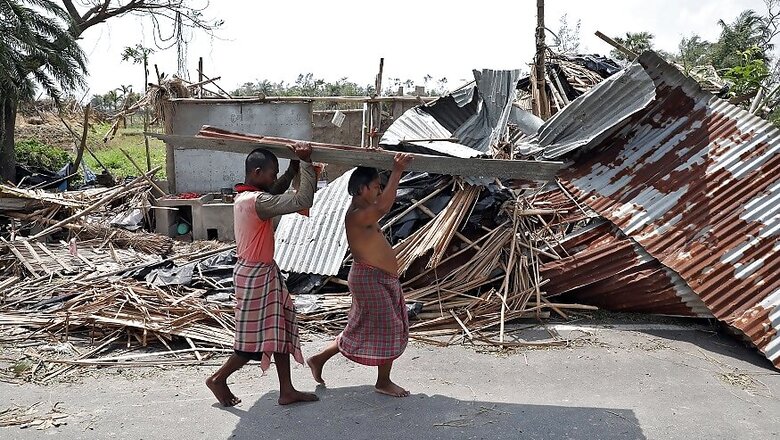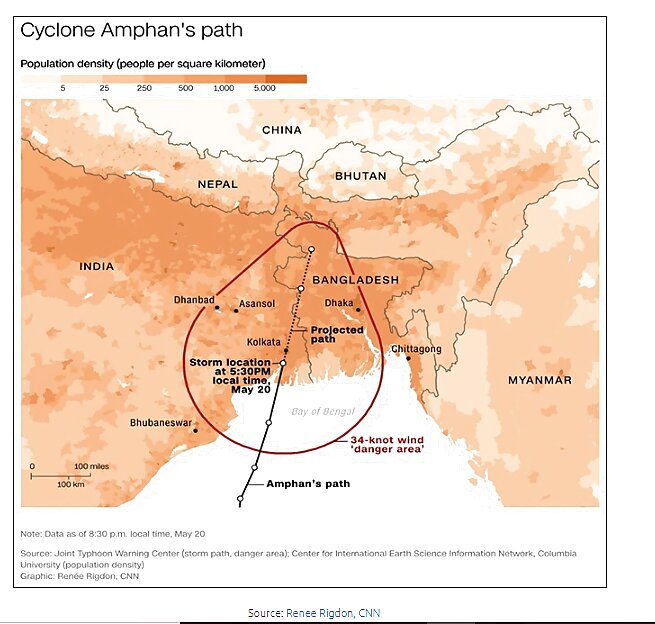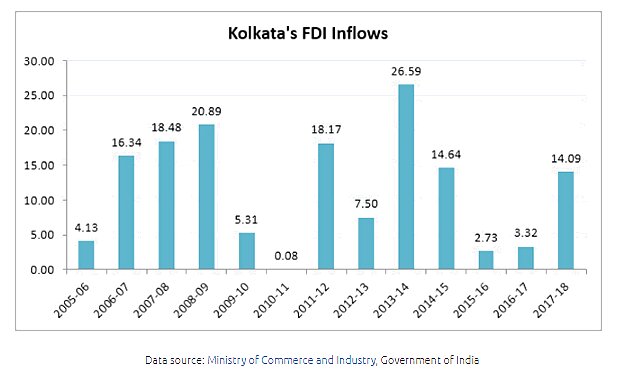
views
The city of Kolkata cuts a sorry figure with the death toll at 19 due to Cyclone Amphan. On 20 May, the monstrous cyclone made landfall at around 20 km East of Sagar Island in the Indian Sunderbans in West Bengal. This century’s strongest cyclone in the Bay of Bengal wrecked havoc in large parts of the state and devastated Kolkata in a way that was not seen in many decades. On the same day, West Bengal also recorded 3 more COVID-19 deaths and 142 additional positive cases.
As thousands of trees were uprooted in the city razing a substantial amount of property to the ground, both physical and virtual connectivity has come to a near standstill in this part of the country due to the joint effect of the cyclone and the ongoing pandemic. In fact, this article was researched for and written over three days using intermittent internet signals from a neighbour’s mobile device.
The Kolkata airport was flooded into a lake and the city’s iconic College Street known as Boi Para (locality of books) have incurred unprecedented losses in book stocks amounting to approximately ₹6 million as per early estimates.
It is very rare in the history of modern India that one of the country’s largest cities continues to stand in ruins, days after the cyclone. Many localities in the city, even within the COVID-19 containment zones, grapple with no power or water supply due to the cyclone. Many television and internet operators claim that restoration of connections could take weeks. The following map shows Cyclone Amphan’s path from the Bay of Bengal into Bangladesh via various cities and towns in West Bengal, including Kolkata.

The cyclone had passed Kolkata through the eastern fringes of the city. This has not only shaken the residential towers in this area, but has also damaged a large number of private hospitals treating COVID-19 patients along the Eastern Metropolitan Bypass.
Additionally, it has also disrupted the supply of medical equipments to these hospitals and has limited the scope of telecommunication between the admitted patients and their family members. Unable to handle the dire situation by the state’s own capacity, the Chief Minister’s plea to the Centre was accepted and five columns of Indian Army was sent on 23 May to restore infrastructure in the capital city of West Bengal. Kolkata’s plight in the current situation is twofold:
i. A large number of workers required for the restoration process of the city, especially the ones for the Calcutta Electric Supply Corporation (the city’s sole power supplier), are migrant workers from neighbouring states who have returned home amidst the COVID-19 scare. Additionally, at the ground level, the lack of workforce in all sectors has invariably delayed the restoration processes in the city.
ii. Owing to the COVID-19 disaster, the Kolkata Municipal Corporation (KMC) elections slated to be held earlier this year were indefinitely postponed. As a result of this, Councillors of all the 144 wards under KMC have lost their signing authority due to the expiry of their five year tenures. Even though a Board of Administrators headed by the outgoing Mayor was set up on 8 May, this new arrangement under such exceptional circumstances has undoubtedly led to confusion at the administrative levels responsible for the provision of civic amenities to the residents of Kolkata.
Kolkata ranks second, after Mumbai, in terms of Indian cities with the largest population densities. This is also one of the reasons why Kolkata has become the epicentre of COVID-19 infections in eastern India. The city which holds an estimated population of about 4.5 million people as per 2011 census, is larger than population size of sovereign nations like Croatia.
Given that Kolkata is the state capital and the administrative nodal point for foreign investments in this part of the country, the physical infrastructure and human capital embodied in the city and adjoining districts are relatively higher compared to the rest of the state. The fact that the cyclone swept across in full force has immensely damaged the region’s economy. The following graph shows the Foreign Direct Investment (FDI) inflows into Kolkata’s RBI regional office over a period of 11 years, as per the latest available statistics.

Amphan had a stronger economic impact than the previous cyclones because of its crippling effect on the dense urban regions in and around Kolkata. Recent estimates show that the cyclone induced costs incurred by West Bengal is to the tune of $13.2 billion. Dividing this loss by Kolkata’s population proportion (Kolkata’s share in West Bengal’s population is approximately 4.9 percent) roughly projects the city’s loss at an atrocious value of $647 million. The loss in physical and human capital will have a detrimental effect in attracting foreign investments into the state capital which has shown a phenomenal FDI growth of about 241 percent from 2005-06 to 2017-18. However, restrictions on human mobility and economic activities due to the pandemic have undoubtedly helped in bringing down the human casualties by a large margin.
In conclusion, it must be noted that the COVID-19 pandemic has exposed the fault lines in the global economic order. The situation has directed us towards a growing importance of sub-regionalism in order to increase the efficiency of national economic systems with lower dependency on Chinese supply chains.
Additionally, a large number of foreign companies too are expected to shift their manufacturing bases from China to India. In view of this, Kolkata is poised to grow in importance as one of the nodal administrative points for India’s ‘Act East Policy’ that could connect India to the larger product and input markets in South East Asia, as a potential alternative to China’s Belt and Road Initiative (BRI). However, the vulnerabilities depicted by Kolkata due to this super cyclone in the Bay of Bengal could impede the city from operationalising economic linkages with the larger South East Asian geography, if it fails to handle such disasters more deftly in the near future.
Hence, West Bengal and especially Kolkata’s disaster preparedness, governance and prompt action in the light of such natural calamities are of utmost importance in the years to come.
This article first appeared in ORF.



















Comments
0 comment